Introduction
When a child is born, the first food it will receive is milk. Whether it is breast milk or another form of infant ready formula, a child will receive its nourishment from dairy products.
There are many different forms of dairy products that are produced from raw milk. The following report will demonstrate the effects, both positive and negative, on dairy products. It will also delve into how dairy products affect people residing in Saudi Arabia.
The Kingdom of Saudi Arabia, which is a homeland of Islam and Arab people, occupies the largest part of the Arabian Peninsula (Smith, 2012). The literary uniqueness of Saudi Arabian nation is that it is mainly composed Muslims and Arabs, connecting them to millions of people outside the country. Saudis also identify themselves with the modern state and its national culture, the Al Saud, with the state’s cultural and geographical surroundings (Smith, 2012).
The report will tell us about the different nomadic groups in the country, what are the food customs of the country that affect the consumption of dairy products and how the population demographics react towards the consumption of dairy products?
After that the impact of dairy products on the human body in general will be analyzed and narrowed down towards the Saudi population. At the end recommendations will be made that can be useful to minimize some of the negative effects of the dairy products on the human body.
Background
The people of Saudi Arabia originated from wandering tribes that were affluent sheep and goat herders (FAO, 2012). They continue to maintain many of the traditions of their past. Today, Saudis still eat traditional food like in spite of the fact that most of the Saudis have transformed themselves according to urban lifestyle. Mecca, which is a religious and spiritual centre of Islam, is also located in Saudi Arabia. The customs and laws of Saudi Arabia, based on Islamic values, include the dietetic boundaries against eating pork or drinking alcohol.
Saudi Arabia, the third-largest country in Asia, constitutes about 4/5thof the Arabian Peninsula. Other countries that occupy the peninsula are: United Arab Emirates, Qatar, Oman, Bahrain, Kuwait, and Yemen. All of these countries are geographically smaller. A thin plain runs next to the Red Sea coast; the Hijaz Mountains (Al Hijaz) ascend from the sea (Smith, 2012). A third of this region is desert. There are no natural bodies of water other than man-made wells.
Oil reserves are the important factor that makes Saudi Arabia wealthy. For many years, residents of Saudi Arabia made their living as farmers, herders or traders. Then, in the mid-1900’s, oil was discovered and became a valuable commodity. In general, the people of Saudi Arabia consume fresh milk from goats, sheep and camels. In addition, they enjoy some of the same milk products that the rest of the world consumes, such as yogurt, cheese, butter and ghee. Millet, a cereal, was also eaten, usually with rice. It is cooked in water and consumed as gruel. Barley and wheat are made into bread. Consuming meat is reserved for special occasions: weddings, traditional events or when guests are welcomed into one’s home. Goat and camel meat is rarely used in food, while lamb is the most frequently eaten kind of meat. Coffee and tea are typical beverages, as well as a type of buttermilk made from fermented milk (Smith, 2012).
If we compare Saudi Arabia with its neighbouring countries we can clearly see that there is a different consumption trend of dairy products because of the better economy and infrastructure of the country. The political system also plays a vital role in the state of consumption because the kingdom’s rules have maintained a certain balance that provides the population with the commodities of basic necessity at a reasonable price (Chan et al, 1995)
Secondly if we see the culture of the country it is different as compared to the neighbouring countries because Saudi Arabia is a kingdom and bases are laid on the principles of Islam which set the foundation of the culture on a different note there is many other countries clearly stand Saudi Arabia out among the neighbouring countries who have adopted a different system.
The differences in the social, economic and political system have a considerable impact on the consumption of dairy products of the country. This provides the population with a unique sense of trend that how they can consume and what traditions or food customs should follow.
The graph in figure 1 shows the undernourishment level of the Saudi population.

These were the latest statistics that were found and was updated in 2011. Saudi Arabia had a very low level of undernourishment in 2006-08, the latest period available; less than 5% of the total population was undernourished. We can clearly see that the food consumption has increased and the proportion of undernourishment is low. It could be showing a positive sign of the consumption of dairy products in Saudi Arabia.
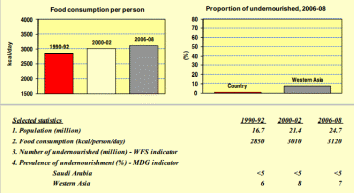
As from the above graphs we can see the pattern of food consumption of the Saudi Arabia as compared to the neighbours. We can clearly see that the food consumption per person is increasing even if the population of the country is increases this shows us that the country is self-sufficient in providing the population basic food commodities in which dairy products are on top. From the second graph we can see that the proportion of undernourished population as compared to the western Asian countries is relatively low this is a positive sign for the country that shows that the country has a healthy economy to feed up the population.
The effects of dairy products
Positive Effects of Dairy Products
In today’s world, when due to various work related and other issues, mothers can’t feed their infants with their own milk, dairy products come to their rescue. Dairy products are considered to be supplements of mothers’ milk. Due to innovations in science it has been possible to make dairy products compatible with the human body to a great extent. “Milk and dairy products, which contain many essential nutrients, are important for the body and for its development. Dairy products are the best source of calcium, which is vital to strengthen bones and for a healthy nervous system” (Musaiger et al, 2012).
The most important ingredient of dairy products that helps growing children is Calcium. Calcium, as is known, helps in making our bones stronger provided that the intake is within the permissible limits. “The recommended daily allowance of calcium is approximately 800 – 1000 mg, although 1200 mg is ideal, according to the most recent update by the U.S. Food and Drug Administration (FDA)” (Lee & Wei, 2002). Calcium helps our bones in maintaining the body structure, keeping the bones healthy and their re-calcification. So calcium is a critical part of the human anatomy. Shortage of calcium in human body might result in destabilized bone structure and simultaneously osteoporosis. Insufficient presence of calcium in human body may be the cause of kidney stones and spasms. Another important role that calcium plays is that its ions act as transmitters of various body chemicals to the areas where they are required. Calcium also helps in blood coagulation. So calcium is an indispensable part of the human body.
Dairy products help human beings to resist the dangerous effects of metabolic syndrome. Disorders of metabolic syndrome may lead to heart related diseases and diabetes. According to one of the researches, “Negative relationships were found between consumption of milk and dairy products and the syndrome… Milk intake showed no significant trend with incident diabetes” (Milk and dairy foods, 2007).
Calcium also helps in regulating the body weight even though it is in an indirect manner. Scientifically, body weight depends on the relation between the energy available in the human body and its utilization. It is believed that calcium and various dairy products have an effect on the energies in human body. In the following figure is an explanation on how to maintain a balance between the energy available and the utilization of energy (Teegarden, 2005):
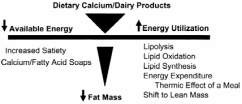
Basically, calcium breaks the fat cells and makes them lean. So in a way it may be understood that in cases of calcium deficiency, there are chances of obesity as well. In addition to calcium, dairy products have other ingredients that help in balancing the energy levels of the human body. For example, Amino acids help in the production of proteins. “Some dairy items have impressive levels of two things most of the people need more of: calcium and protein…Just a cup of light yogurt, for example, gives human beings a third of their daily recommended calcium intake, along with 17% of your estimated daily protein intake” (Magee, 2006). The following table depicts the quantity of calcium and protein in various dairy products:
Table 1: Depicts the quantity of calcium and protein in various dairy products. Source: (Magee, 2006).
Dairy products are very good substitutes for mothers milk during infancy. During adulthood, these products act as nutrients for the body. Dairy products are believed to contain vitamins and nutrients; Calcium, Riboflavin or vitamin B2, vitamin D, and protein. As a matter of fact, all these ingredients of dairy products are very crucial for maintaining a healthy body. So it is very important to understand the quality and necessity of each one of these vitamins and other nutrients. But first it should be known as to what the various nutrients are required by the human body.
Negative Effects of Dairy Products
Apart from the positive effects, there are several negative effects of dairy products. “Cow’s milk is an unhealthy fluid from diseased animals that contains a wide range of dangerous and disease-causing substances that have a cumulative negative effect on all who consume it” (Rietz, 2002). “…cow’s milk, especially processed cow’s milk, has been linked to a variety of health problems, including: mucous production, haemoglobin loss, childhood diabetes, adult onset diabetes, heart disease, atherosclerosis, arthritis, varicose veins, kidney stones, mood swings, depression, irritability, allergies…” (Dewey, 1998).
There have been several researches that show that dairy products are somehow related to various health issues in human beings. Such researches have suggested that following are the major health problems arising due to consumption of milk and other dairy products: Allergies, breast cancer, diabetes, ear infections, fat, growth factor, heart disease, iron deficiency, juvenile illnesses, killer bacteria, lactose intolerance, mad cow disease, osteoporosis, and vitamin deficiency (Dewey, 1998).
The danger in consuming milk and other dairy products can be understood by the fact that, “Cow’s milk can have traces of anything the cow ate, including such things as radioactive fallout from nuke testing” (Rietz, 2002).
Since cows are given doses of antibiotics and other drugs, some traces are bound to be there in the milk that humans drink. Such traces might be harmful for human body (Neuman, 2011).
Pasteurization is another problem that dairy milk faces. Pasteurization is the heating process of milk in order to destroy the bacteria and other unwanted ingredients. But in the process, the enzymes are also destroyed. These enzymes are very important for human beings.
In order to make low fat milk, cow’s milk is homogenized. Homogenization removes the butterfat and produces skimmed milk. Even though the product has a good market most of the people are unaware of the fact that the homogenized milk cannot be digested fully by human body.
It has been discussed that dairy products, if taken within the permitted quantities, are helpful for the human body. It is a known fact that calcium is one of the main nutrients for human body since it strengthens the bones. But it should be understood that likewise other intakes, the intake of calcium also should be in a limited or recommended quantity. Excess intake of calcium may prove to be disastrous for the human body. There are some people whose bodies are not able to digest calcium. In both the above cases, the calcium intakes deposit in the kidney and gradually a stone like thing forms. This is called the kidney stone. Kidney stone may prove to be very painful and at times might result in death. If the stone is big enough, it might block the urinary bladder and the person will not be able to pass out urine. This might cause sepsis. But doctors caution: do not necessarily decrease the amount of dairy, but be aware of it. Rather, make sure the amount of calcium supplements is decreased (Mayo Clinic, 2012).
The Effects of Dairy Products on Human Body
Below is a table that depicts the bioactive components present in dairy milk that might cause health issues in human beings:
Table 6: bioactive ingredients in dairy milk. Source: Bauman et al (as cited by Lock et al, 2008).
Effect of low and full fat intakes affect blood
Consumption of fats is a necessary factor for keeping the body healthy. Fats may be said to be the foundation of indispensable fatty acids such as linolenic acid and lionoleic acid. Fats are also of assistance in transmitting important vitamins. Food becomes tastier by the presence of fats. But as excess of everything is bad, likewise, excess consumption of fats also may result in severe body disorders such as obesity and may give rise to dreaded diseases such as heart ailment and cancer. “The American Heart Association suggests a diet with total fat of less than 30% and saturated fat intake less than 10% of daily calories to reduce the risk of coronary heart disease (CHD)” (Meksawan et al, 2003). Fewer intakes of dietary fats may result in weakening of the body. Therefore, the fat intake should be in comparison to the energy being used by the body. Two individuals in different streams of life may have different requirement of fat intakes. Like for example a weight lifter or boxer might require more intake of fats than a person who does an administrative job that doesn’t require much physical labour. This is because the energy being used by the bodies of these people is different. There are various kinds of fats; Lipid, lipoprotein, triglycerides, saturated fats, mono-unsaturated fats, poly-unsaturated fats, hydrogenated fats, trans-fatty acids and Omega-3 fatty acids. The following table suggests the manners in which various fats affect the body health of human beings (Anderson et al, 2012):
Table 7: How various fats affect body health of humans? Source: (Anderson et al, 2012).
“Dietary fat changes your blood chemistry and influences your risk of cardiovascular disease” (Traister, 2011).
Possible effects on bones and dental health
Milk is the most commonly consumed food item and there are certain positive effects that it has on the oral or dental health of human beings. As such, there have been numerous researches on the topic. It is a well known fact that calcium is very good for bones. Since human teeth are also bones, calcium is good for teeth as well. Regular intake of product having lactic acid, such as yoghurt, may help in healthier gums and teeth. Although the consumption of dairy products will not eliminate gum and tooth disease completely, it does help to reduce the occurrences of them (Fyiliving, 2011). “The composition of milk has been compared with that of saliva and like saliva it harbours a multitude of antibacterial agents including immunoglobulin and possesses remarkable physical properties.” (Bowen, 2002).
There are numerous evidences that show that sufficient intakes of calcium increase the bone build-up during the growth stage and at the same time slow down the loss of bones due to age. Calcium also helps in the threat of fractures due to osteoporosis. Osteoporosis is a very intricate, multi-factorial and dangerous disarray of bones. Only calcium has the peculiar quality that can prove to be an important and effective preventive measure. The calcium present in dairy products is as good as any calcium appendage.
It doesn’t mean that dairy products are to be consumes only because of their calcium contents and also its not calcium alone that is beneficial for the bones. Dairy products are very composite in nature and contain several nutrients that are very vital for the growth and maintenance of bones. The combined effect of such nutrients cannot be substituted by any single nutrient even though calcium is present in dairy products in abundance. “Bone growth is stunted in general malnutrition, and specify bony abnormalities develop with deficiencies of protein, ascorbic acid, vitamin D, magnesium, zinc, copper and manganese, to name only a few of the better studied instances” (Heaney, 2000). Bones are composed of 95% of such matter that needs incessant supply of nutrients that can be available in dietary intakes. Calcium phosphate and protein constitute almost 50% each of this matter. It is understood that without proper intake of these nutrients by way of food intake, it will become impossible for the body to maintain its structure.
Another important factor is that since it is being discussed about the role of calcium in the growth of human body it doesn’t mean that once the human body is fully grown up, the requirement of calcium and other nutrients ceases. Actually there is a daily loss of huge amounts of calcium from the body. This loss is mainly due to the use of energy by human body. Other sources of loss of calcium are hair shedding, sweating, urine and use of calcium during the digestion process. Even grownups need sufficient quantities of calcium in order to maintain the bone structure of their bodies. In circumstances where there is no intake or less intake of calcium the body tries to compensate the shortage by extracting its requirement from the bones. The result of such circumstances may be disastrous for the bone strength and simultaneously the body structure. So it’s evident that dairy products are vital for bone health.
A research done on the ‘consumption of dairy products’ by Shimazaki et al revealed that continuous intake of calcium in required quantities can act as a healing process for periodontal disease. Yet another study showed that a variety of bioactive peptides and calcium present in milk help in maintaining the dental health by way of enamel coating and the prevention of caries (Dairynutrition, 2012).
Effects on the skin
There have been a number of researches on the effect of dairy products on human skin. Almost all the researchers conclude that excess use or intake of dairy products has a negative effect on the human skin by way of acne. There is a correlation between dairy products and acne. People in countries where dairy products are not consumed to a greater extent have smoother skins, free from acne and on the contrary people in countries where dairy products (especially pasteurized) are promoted and consumed to a greater extent, suffer from skin problems i.e. acne. It is understood that milk drinkers have greater risk of having acne than those who don’t drink milk or are seldom milk drinkers.
But there is one dairy product that is an exception and that is yoghurt. Yoghurt has many beneficial qualities including the one that it glows the human skin. Low fat yoghurt in particular has vitamin A that boosts the collagen of the skin. Collagen helps smoothing the wrinkles on the skin. When the body experiences good digestive health, it reflects in the healthiness of the skin.
The scientific reason for the acne is that the human body reacts to the intake of dairy products and produces a sort of chemical called histamine. Secretion of Histamine causes soreness and irritation that makes the human skin unbalanced and results in skin allergy.
Eczema has more effect on the little ones. The parts of human body that are more prone to this kind of irritation are face, arms and legs. People suffering from this disease have red blisters and if they are scratched, they become more painful. But as the children grow older, the effect of eczema decreases.
According to Ann Yelmokas McDermott, “Essential fatty acids are responsible for healthy cell membranes, which is not only what act as barriers to harmful things but also as the passageway for nutrients to cross in and out and for waste products to get in and out of the cell” (as cited by Bouchez, 2005).
The allergy caused by dairy products can have a direct impact on the skin with problems such as itching and eczema. So the best option of keeping away from acne or eczema is to avoid the consumption of dairy products.
Effects on the heart
As far as human heart is concerned, dairy products have some positive as well negative effects. During the homogenization process, the fat globules present in milk break into finer particles and this enables them to be absorbed into the blood stream with ease. If human blood has more of fat, it is harmful for the heart. But low fat dairy products have proved to be beneficial for human heart. Low fat dairy products help reduce the blood pressure and cholesterol. Calcium, Vitamin D, and potassium contained in dairy products increase the body’s “good” cholesterol, while decreasing the bad one (Reuters, 2010).
One may wonder as to what are good and bad cholesterols. Well, actually there are two kinds of cholesterol present in human body. These are the ‘High Density Lipoprotein’ also called the HDL and the ‘Low Density Lipoprotein’ also called the LDL.
The HDL is referred to as the good cholesterol and the LDL as the bad one. It has already been determined that about a quarter of the total blood cholesterol is lugged by the high density lipoprotein. HDL is referred to as being good cholesterol because of its remedial powers with regard to human heart. Sufficient quantities of HDL (60 mg/dL) prevent heart from getting any ailments such as heart attacks. But on the other side, if the level of HDL drops to less than 40 mg/dL, it may be a risky affair because it may cause heart disease. There are certain experts who believe that HDL is more likely to tug cholesterol to the liver and removes surplus cholesterol from the plaque in arteries. This retards the speed of formation of plaque.
The LDL is referred to as the bad cholesterol. When there is excess flow of LDL in the blood streams it may result in deposition in the arteries. The recommended level of LDL is less than 100 mg/dL. In case the LDL is higher than 100 mg/dL, it should, in no circumstances, exceed 150 mg/dL. LDL mixes with other matter and forms a hard and thick deposition inside the arteries. This may result in the inner diameter or the opening of the arteries becoming less and a time comes when that particular artery is totally blocked. The arteries even become less flexible. The outcome situation is normally referred to as ‘Atherosclerosis’ and this is when heart ailments start.
In order to keep the levels of LDL under control and within the recommended limit, people should maintain an active life style at the first place. Secondly, the daily diet should have less cholesterol and more of fibre. This will keep the LDL level within the recommended limits and the heart will be hale and hearty. One cannot escape from the genetic effects or the hereditary factors involved in the body features and functions. But at least precaution can be taken as far as the diet is concerned.
Apart from the HDL and LDL, there are two more substances that might have an ill effect on the human heart. These are ‘Triglycerides’ and ‘Lp(a) cholesterol’.
Just as yoghurt is good for skin whereas other dairy products are harmful, similarly there is a difference in cholesterol contents among different dairy products. Tholstrup claims that both milk and butter have more cholesterol than cheese (Tholstrup, 2006).
Effects on weight
Berino believes that a low calorie diet does not necessarily reduce the body weight. It is the daily exercise regime that may help in weight loss (Berino et al, 2005). Actually this is being practical. Berino is right because one may consume low calorie diet once or twice in a day but what about other things that one might eat during the day? Just for example, if a person needs 300 calories a day and that person drinks 150 calorie milk twice a day, then what about the calories consumed in breakfast, lunch and dinner? There are always excess calories present in a healthy human’s body and these extra calories need to be used. There are two ways in which a person can use the extra calories or energy; either the person does some manual work or does some exercises on a daily basis. So it’s just a way of satisfying oneself to say that milk controls the body weight.
Dairy products come with different fat contents. People may choose what is right for them or what is required for them. Awareness about the effects of dairy products is a must. In order to lose weight, only low fat dairy products should be consumed but if any person wants to gain weight, full fat dairy products would be a good option. Calcium intake controls what the human body does with calories, and thus the calcium in low-fat dairy will assist the body to burn those unwanted calories (Zemel, 2003).
It is a proven fact that almost 60 to 65 percent of the fat contents in dairy products are saturated. There are certain products like “ice cream, sour cream, whipped cream, coffee cream, and whole milk” that are full of saturated fats. Ironically, the “low-fat dairy products” also have high contents of “saturated fat”. Skimmed milk is one exception that is recommended for milk drinkers older that one year (Hobbs, 2012).
Effects on the immune system
The immune system of human beings guards the body from foreign and unwanted substances such as bacteria, parasites, fungi, viruses, etc (Traister, 2011b). Allergy from food is caused due to the immunity of the body. Dairy products are the cause of various allergies such as diarrhoea, constipation, etc. Dairy products contain ample quantities of vitamins, nutrients and proteins to strengthen the immune system but there are times when the body doesn’t need them and may refuse to accept the intakes that might result in allergies. So even though dairy products are beneficial for the immune system, at times they may prove harmful as well.
Since most of the baby foods are dairy-based, it may be said that the first alien protein that enters a human body is cow’s milk. Now since such products are administered orally, there are certain “immune responses” that are the cause of immune related malfunctions in human bodies in countries where dairy products are promoted and consumed too much. The fact should not be undermined that a healthy immune system is the key to a healthy body free from any sorts of disorders (Thompson, 2012).
The levels of WBCs depend on the basis and physical condition of the milk. Usually there should be “one to seven drops” of WBC (white blood cells) in one normal glass of milk (8 ounce). Due to administering of “bovine growth hormones” to cattle for more yield of milk, sometimes the level of such hormones exceeds the recommended level and poses danger of various kinds of cancer in human beings. Ironically, on being administered the “bovine growth hormones” the cattle also get infected with ‘Mastitis’. Due to ‘Mastitis’ blood cells are found in milk.
Cattle milk contains lactose and in order to digest this lactose, human body produces lactase. Until the infant is breast feeding, there is no problem but once the breast feeding is stopped and supplementary food is given to infants, the production of lactase decreases significantly and as a result the lactose cannot be digested properly and it enters the blood stream. If this process goes on continuously for a long period, the immune system may react in a manner that may be harmful for the human body. And it is very awful to know that in such cases, the immune system starts harming the body instead of expelling the unwanted substances.
Traister claims that “fermented dairy products” have the capability and quality of enhancing the “immune system” and defend the human body from being contaminated by infections such as “gastrointestinal and respiratory infections” (Traister, 2011b).
Every food item has its own negative or positive qualities. Like some are good for human skin but bad for the heart. Similarly there are certain products that are good for the immune system and some are bad. The following are the foods that boost the immune system: Vitamin C, Vitamin E, Carotenoids, Bioflavenoids, Zinc, Garlic, Selenium, Omega-3 fatty acids, etc (AskDrSears, 2011). Following are the foods that lower the immune system: Fatty breakfast, soda, foods that help in keeping awake like coffee, olestra, multivitamin, acidic foods, lemon wedges, nuts, flu shots, etc (Pharmacy Technician Certification, 2009).
The effects of dairy products in Saudi Arabia
Vitamin D is one of the most important substances required by human body. There are two kinds of vitamin D and their sources are also different. One is vitamin D2 (ergocalciferol) and it is found in eatables such as dairy products, “mushrooms, fish, and egg yolk”. Another form of vitamin D is vitamin D3 (cholecalciferol) and it is obtained from the natural resource of sunlight. The deficiency of vitamin D may cause rickets and/or osteomalacia. Sufficient intake of Vitamin D is also essential for the “calcium metabolism” that makes the bones stronger and avoids bone fractures.
Men in Saudi Arabia
One would wonder that since there is abundance of sunlight in Saudi Arabia, there should not be any problem in the people of Saudi Arabia getting vitamin D3. But researches show a different face. In spite of being one of the countries where there is no dearth of sunlight, Saudi population has been found to have deficiencies of vitamin D. The following table depicts the data of healthy Saudi men:
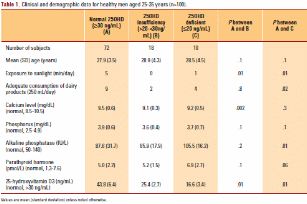
Saudi men have the tendency of having a deficiency of vitamin D. According to Sadat-Ali et al, almost 28 to 37 percent of Saudi men have a deficiency of vitamin D (Sadat-Ali et al, 2009). The figures are astounding but nothing is being done to counter this problem.
Dairy products help men to resist the dangerous effects of metabolic syndrome. Metabolic syndrome may result in cardiovascular disease and/or diabetes. Homogenized milk is not advisable for men because the fats have been broken into finer particles and may be easily absorbed by the blood stream. This ultimately has a negative effect on the heart’s health.
Another negative effect that dairy products have on Saudi men is the problem of obesity. Due to excess intakes of dairy products Saudi men are mostly obese or overweight.
The following table depicts the risk factors being faced by Saudi men and women.
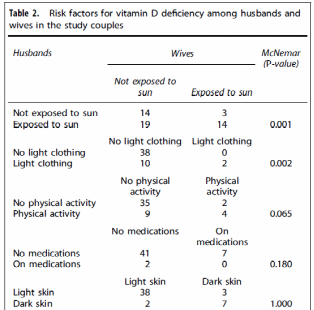
Women
Women suffer an increased deficiency in Vitamin D because of their lack of exposure to the sun. This seems to be odd since Saudi Arabia is sun-drenched, however, because it is so hot, many individuals do not spend an excessive amount of time in the sun. Osteoporosis is a disease caused by lack of calcium. This disease is widespread in the Arab countries and female teenagers and aged people are more prone to this disease (Musaiger et al, 2012).
That being said, although dairy does contain Vitamin D, with the reduced sunlight exposure, it is not enough to keep both men and women from becoming deficient in that nutrient. Saudi Arabian women tend to give birth to three or more children in their lifetimes, leaving an increased risk of weight gain. With the type of dairy products being only made from raw milk, and yet a decreased consumption of Vitamin D enriched foods, the women seem to have it tougher than men when it comes to the issues caused by lack of dairy products.
Children and adolescents
It is a misconception that dairy products always make a person obese. This happens only when dairy products are consumed in excess. In fact, milk and other dairy products are crucial for maintaining a healthy body and to be more specific, children and teenagers need to consume milk and other dairy products so that they remain fit (Greer et al, 2006).
Vitamin D and calcium are the most important substances required by human body and these two were found to be facing deficiency in Saudi children and adolescents. The average calcium consumption in Saudi children and adolescents has been found to be 60 percent and that of vitamin D 23 percent. However, female children and adolescents have been found to have lower vitamin D levels than their male counterparts. The following table suggests the intake of vitamin D, calcium and other requirements by Saudi children and adolescents:
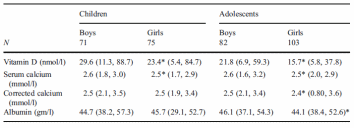
The following dietary programme should be followed in order to remain fit and healthy in the Arab countries:
- A variety of different foods should be consumed daily: Human beings require at least 40 different nutrients in order to keep themselves healthy and free from any sort of illness. The following table shows the recommended daily intakes of food:
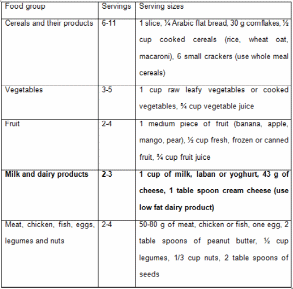
- Foods and drinks having high percentages of sugar should be avoided
- Intake of salt should be minimised
- Water should be drunk frequently
- A proper balance between height and weight should be maintained
Dairy Products in Saudi Arabia
Dairy products consumption
Saudi Arabian dairy industry is one of the largest and most urbane amongst all the Middle Eastern countries. The past years have witnessed significant growth in this sector. The consumption of dairy products has also increased and milk and flavoured milk are two of the most preferred drinks among the dairy products in Saudi Arabia.
During the year 1999, the overall consumption of milk was 335 million litres. The consumption of ‘laban’ during the same year was 265 million litres. Given the official figure of Saudi population to be 20 million, the per capita consumption of milk and ‘laban’ combined comes to be 30 litres per year. Between 1990 and 1999 there was a steady growth in the consumption of milk and ‘laban’. The years saw a growth rate of 6% that was almost double the growth rate of Saudi population.
Even today, the consumption of milk in Saudi Arabia is increasing at the rate of 6% per annum. This has been possible due to the awareness among the general public about the benefits pertaining to drinking milk. And if figures do count, Saudi Arabia accounts for 59% of the total consumption in the GCC. And for the dairy owners in Saudi Arabia, the revelation of Business Monitor International (BMI) will prove to be a shot in the arm because according to a survey by BMI, the milk consumption in Saudi Arabia is expected to increase by 13%, taking the total consumption to 1.53 million tons by the year 2014/2015 (Saudi Gazette, 2012).
In the year 1993, the share of flavoured milk in the total consumption of milk was a meagre 10%. This grew to 11% by the year 1997. By the year 2000, flavoured milk accounted for 14.5% share in the total milk consumption in Saudi Arabia. During the year 1997, the Saudi government had imposed a ban on the sale of “carbonates” in schools. This proved to be a boosting factor for the sales and consumption of flavoured milk. Majority of the dairies have installed vending machines to benefit from the “impulse purchases”.
A major plus point for the flavoured milk market has been the negative publicity of soft drinks. Since children are the main target for the soft drinks as well as flavoured milk, this negative publicity has increased the sales and consumption of flavoured milk in Saudi Arabia. Due to the awareness programmes, the Saudi women are now well aware that natural products are anytime better than the artificial ones. So they also promote and prefer milk for their children.
The consumption of dairy products in Saudi Arabia in 2009 was as under:
The following pie chart depicts the consumption of dairy products in Saudi Arabia:

Dairy products: Current and future situation
In spite of the fact that the dairy industry of Saudi Arabia is one of the biggest, is at a turning point today. Dairy became an industry in Saudi Arabia in 1970s and has been progressing at an encouraging rate. There are basically two kinds of dairies in Saudi Arabia. One that uses fresh milk for its products and another that uses imported milk powder. It is but obvious that those dairies that produce products from fresh milk are at a disadvantage because their products don’t have much shelf life. They can market their products only in the retail stores and that too not too far away from the manufacturing facility. The reason is the transportation problems. On the other hand the dairies that produce their products from milk powder have an advantage that their products have more shelf life and people prefer the products because they don’t have to buy the products so often.
But there has certainly been a decrease in the gap of sales between the two varieties of dairy products. The following graph depicts the sales figures:
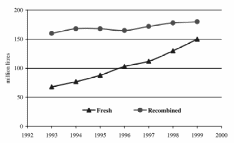
Likewise the world trend, Saudi Arabia will also experience a growth in the consumption of dairy products. People will want to eat products that are rich in proteins and dairy products are one of the better options. The world is on the march towards urbanization and as such the daily schedule of people is ought to become more and more busy. There has been a growth in the food and super market chains all around Saudi Arabia. Moreover, the dairy products from multinational companies give a better option to the consumers. Also, there have been awareness programmes and people are well educated on the benefits of dairy products. As a result, the demand and consumption of dairy products is ought to increase by the years. Hence the dairy industry in Saudi Arabia has a very bright future.
References
Al-Musharaf, S Al-Othman, A Al-Daghri, NM Krishnaswamy, S Yusuf, DS Alkharfy, KM Al-Saleh, Y Al-Attas, OS Alokail, MS Moharram, O Yakout, S Sabico, S & Chrousos, GP 2012, ‘Vitamin D deficiency and calcium intake in reference to increased body mass index in children and adolescents’, European Journal of Paediatrics, vol. 171, pp. 1081-1086.
Anderson, J Young, L & Roach, J 2012, Cholesterol and fats, Web.
AskDrSears 2011, 8 foods that boost immunity, Web.
Berino, J Gold, B Lauber, R & Starinski, A 2005, ‘The impact of calcium and dairy product consumption on weight loss’, Obesity research, vol. 13, pp. 1720-1726, Web.
Bouchez, C 2005, The ABCs of a healthy skin diet, Web.
Bowen, W 2002, ‘Effects of dairy products on oral health’, Scandinavian Journal of Nutrition, vol. 46, no. 4, pp. 178-179.
Chan, GM Hoffman, K & McMurry, M 1995, Effects of dairy products on bone and body composition in pubertal girl, Web.
Dairynutrition 2012, Milk products in dental health: Summary of evidence, Web.
Dewey, D 1998,And you thought milk and dairy was good for you?, Web.
Elshafie, DE Al-Khashan, HI & Mishirky, AM 2012, ‘Comparison of vitamin D deficiency in Saudi married couples’, European Journal of Clinical Nutrition, vol. 66, pp. 742-745.
FAO 2012, Foods and Agriculture Organization, Web.
Greer, F Krebs, N & Baker, R 2006, ‘Optimizing bone health and calcium intakes of infants, children, and adolescents’, Paediatrics, vol. 117, no. 2, pp. 578-585.
Heaney, R 2000, ‘Calcium, dairy products and osteoporosis’, Journal of the American College of Nutrition, vol. 19, no. 2, pp. 835-995, Web.
Hobbs, S 2012, How dairy products may affect weight, Web.
Lee, J & Wei, R 2002, ‘Milk, doing your body good?’, Journal of young investigators, vol. 6, no. 3, Web.
Lock, A Destaillats, F Kraft, J & German, J 2008, ‘Introduction to the proceedings of the symposium “Scientific update on dairy fats and cardiovascular diseases”’, Journal of the American College of Nutrition, vol. 27, no. 6, pp. 7205-7225, Web.
Magee, E 2006, Low-fat dairy offers many health benefits, Web.
Mayo Clinic 2012, Milk allergy: Causes, Web.
Meksawan, K, Pendergast, D, Leddy, J, Mason, M, Horvath, P, & Awad, A 2003, ‘Effect of low and high fat diets on nutrient intakes and selected cardiovascular risk factors in sedentary men and women’, Journal of the American college of Nutrition, vol. 23, no. 2, pp. 131-140, Web.
‘Milk and dairy foods can protect men from metabolic syndrome’ 2007, Nursing Standard, vol. 21, No. 52, p. 17.
Musaiger, A Takruri, H Hassan, A & Abu-Tarboush, H 2012, Food-based dietary guidelines for the Arab Gulf countries, Web.
Neuman, W 2011, F.D.A. and dairy industry spar over testing of milk, Web.
Pharmacy Technician Certification 2009, 10 surprising foods that lower your immune system, Web.
Reuters 2010, Study Backs Heart-Healthy Effect of Dairy Fat, Web.
Rietz, D 2002, Dangers of milk and dairy products – The facts, Web.
Sadat-Ali, M AlElq, A Al-Turki, H Al-Mulhim, F & Al-Ali, A 2009, ‘Vitamin D levels in healthy men in eastern Saudi Arabia’, Annals of Saudi Medicine, vol. 29, no. 5, pp. 378-382.
Saudi Gazette 2012, Kingdom milk demand increases by 6% yearly, Web.
Smith, A 2012, Saudi Arabia, Web.
Teegarden, D 2005, ‘The influence of dairy product consumption on body composition’, The Journal of Nutrition, vol. 135, no. 12, pp. 2749-2752, Web.
Tholstrup, T 2006, Dairy products and cardiovascular disease, Web.
Thompson, T 2012, Are harmful effects of dairy products on the immune system for real?, Web.
Traister, J 2011, How does fat intake change blood chemistry?, Web.
Traister, J 2011b, Does dairy impair the immune system?, Web.
Zemel, M 2003, Weight loss effects of dairy, Web.